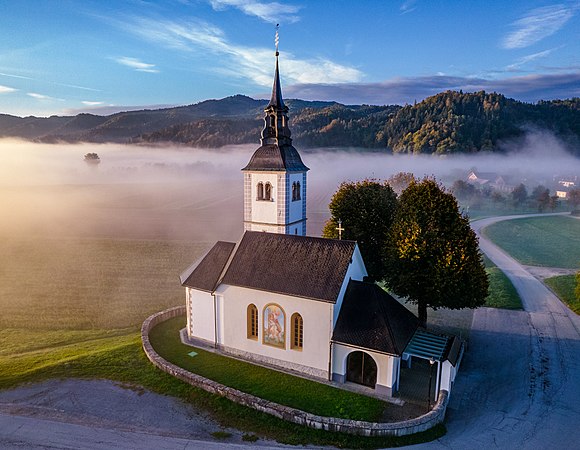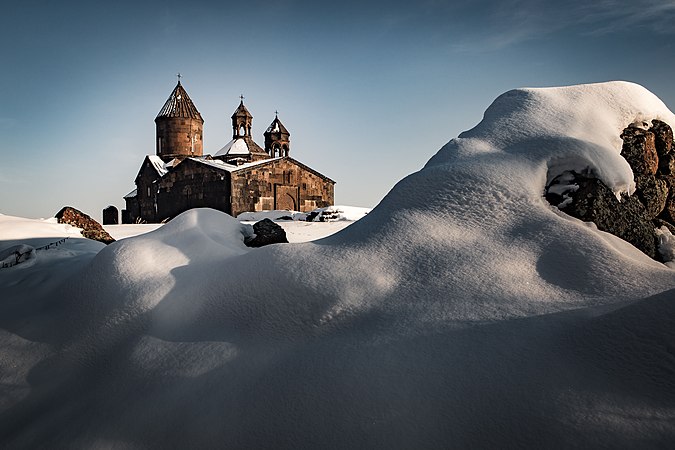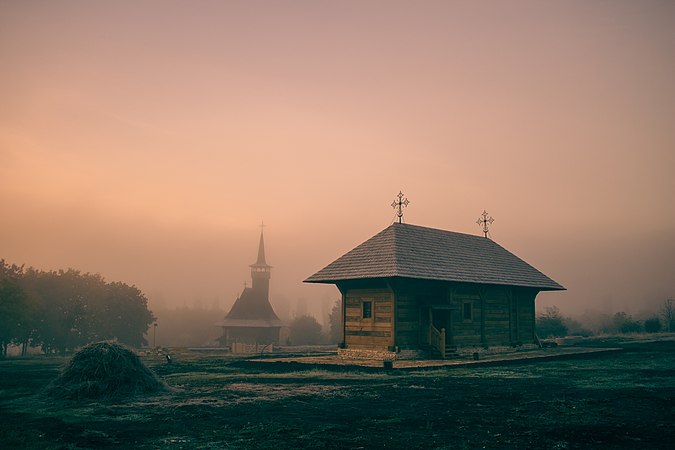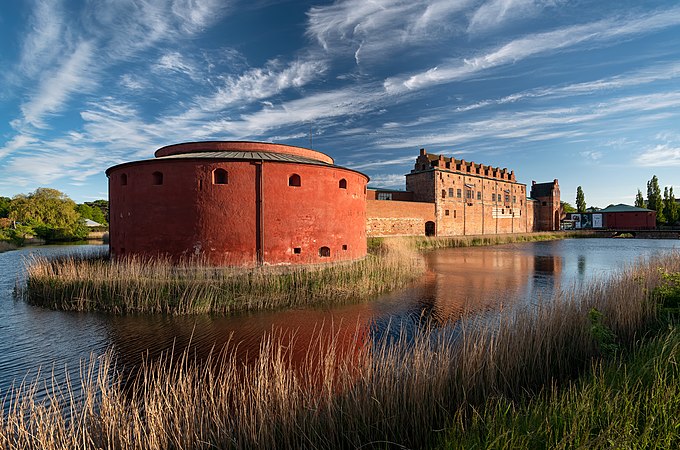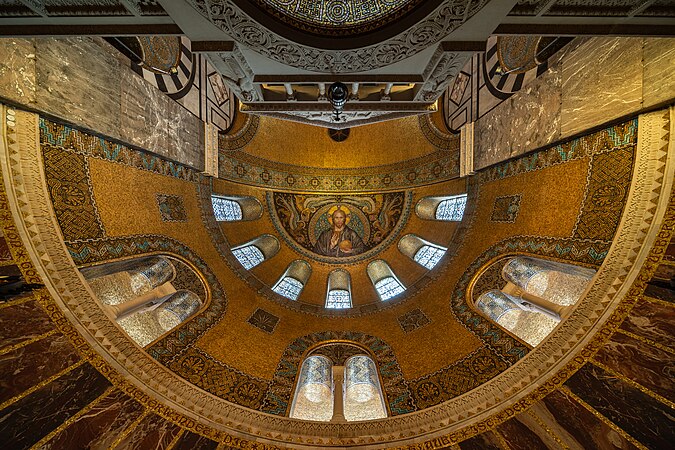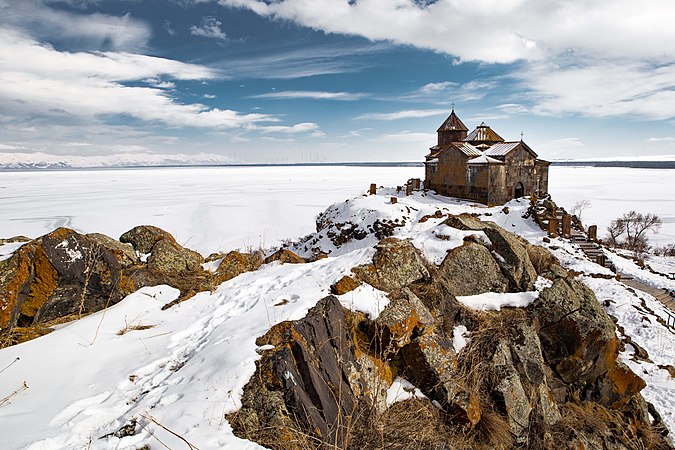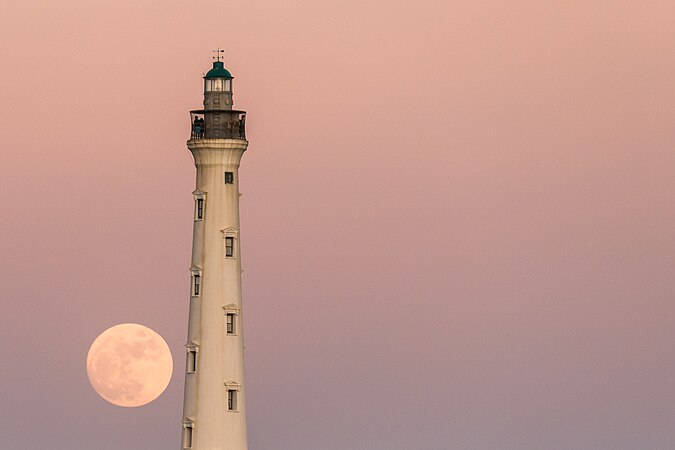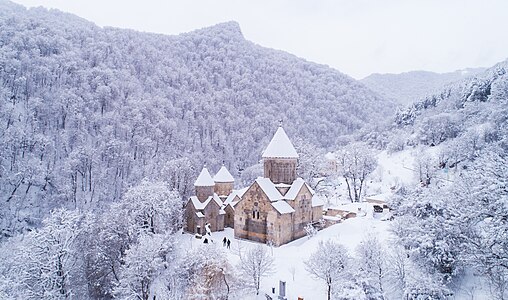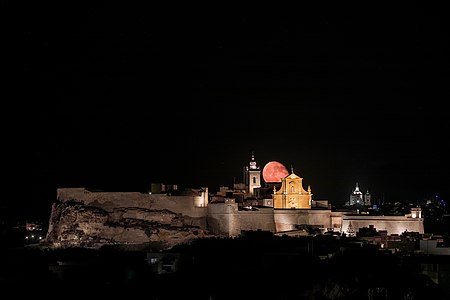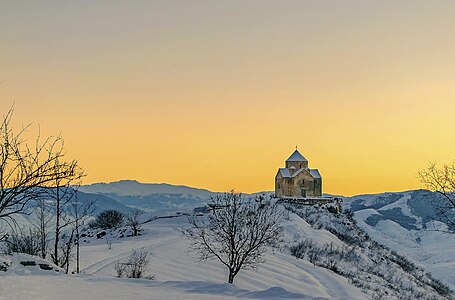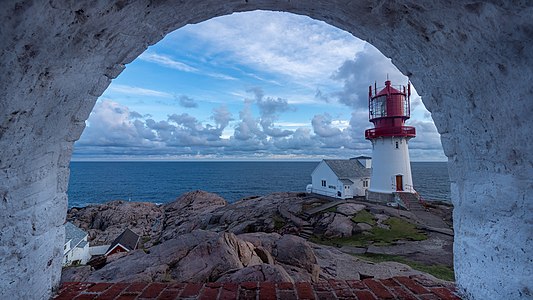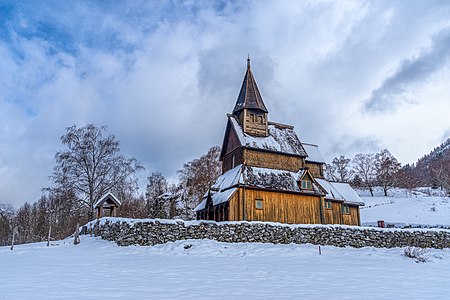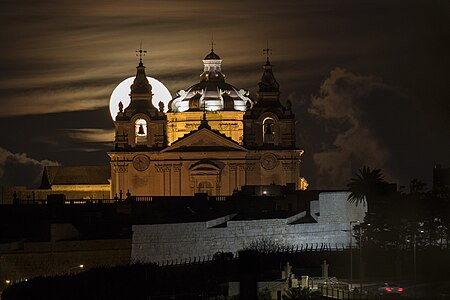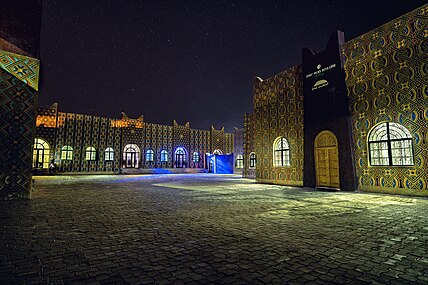Commons:Wiki Loves Monuments 2022/Jury report
| WLM 2022 | Participating countries | Uploaded images | Organizers | FAQ | Help desk | For organizers |
Introduction
This is the thirteenth year in which Wiki Loves Monuments has been organised. In 2022, over 153,000 photos were submitted by 3722 users. As was the case throughout the history of the competition, the contest was organized through a number of national contests coordinated by local volunteers. Each national jury then submitted up to 10 photos to the international stage of the contest. In this year’s edition 36 national competitions have submitted their nominations, resulting in a total of 337 entries for the international jury to consider.
As in previous years, Wiki Loves Monuments 2022 invited people to submit photos of monuments listed within their respective national competitions throughout the month of September. It is heartening to see Wiki Loves Monuments maintain its popularity over the years although there was a decrease in the total number of submissions and the number of participating countries compared to previous years.
In this report we provide some insights in the judging process and outcomes. The report includes a summary of the process steps and announces the winning photos. We have also included the finalists that did make it to the final selection of 46 photos, but did not win a prize. The reasons why the jury members have selected these 15 photos as their top ranking winners are included in this report as well.
Wiki Loves Monuments is the largest photography competition in the world, and reaching this finale is an accomplishment in itself. We congratulate all photographers who have submitted photos that reached this level. We hope you will enjoy the collection of wonderful heritage photographs as much as we did through the jury process and in preparing this report.
How did the jury work?
National competitions, which took place throughout the months of September and October, submitted their nominated photos by 5 December. At this time, a total of 337 were submitted to the non-voting jury coordinator by the national juries of 36 national competitions. These were joined by three others who did not send their images, making a total of 39 participating countries. Each national competition was allowed to submit up to 10 photos. Certain countries elected to submit fewer photos. The international jury was tasked to come up with a final ranking of the top photos over a three-round jury process.
The nominations were collected in the jury tool ‘Montage’, where all 7 jury members independently rated all photos from 1 (poor) to 5 (very good) stars. The jury coordinator collected the photos with the highest average rating: 61 photos.
Jury members were invited to comment via email on these 61 photos and the selection in general, and if any two jury members agreed through a ‘veto’ process that a photo does not belong to the top 25, it would be removed from the selection for the third round. Through this process, 15 photos were removed, and therefore 46 photos remained on the ‘long list’ for the third round.
In the third and final round, the jury members used the jury tool to rank their top-25 from the remaining photos. They each selected 25 photos, and submitted them in order. A first place ranking by a jury member was worth 25 points, a second place 24 points, all the way to 1 point for a 25th place. These points were added together, resulting in a combined jury ranking. Ties were resolved by the highest rank the photos received. The jury members had the opportunity both in the second and the third round to give a reasoning for their vote, which was used as a basis for the jury comments in this report.
What did the jury do?
The international jury was made up by a group of seven experts with varying backgrounds in photography, heritage and Wikimedia, as well as with a diverse range of cultural backgrounds doing justice to the diversity of Wiki Loves Monuments’ participating photos. Members of the international jury did not participate in the national juries, which were excluded from consideration for the international finale. The international team would like to thank them for their service.
The jury members based their judgment on three main criteria:
The first criterion is about the quality of the photo itself. This includes considerations such as the sharpness and resolution, the use of light, and the perspective of the photo. A good rule of thumb is that a winning photo should fulfill the Wikimedia Commons technical criteria for ‘featured picture’ status.
This criterion takes into account the general originality or innovation of the competing photo. The jury looked into whether the subject had been photographed in a similar way before. Jury members were looking for that little ‘extra’ that your photo may contain.
One of the main goals of this competition is to collect good-quality photographs of monuments to be used on Wikipedia. This criteria reflects this consideration. Does the photo represent the monument clearly and can it be used in an encyclopedic context? Is it misrepresenting the monument in any way, or are there any distracting details?
Who was on the jury?
- Laurie Neale first served on the 2020 WLM International Jury. She is an architect trained in Montreal and London who, from The Hague, has worked over the last decades safeguarding cultural heritage with Europa Nostra. She is also a sculptor and multimedia artist.
- Patricia Díaz Rubio is a Chilean social communicator with passion for local culture and heritage. She is the current ED of Wikimedia Chile.
- Fayçal Rezkallah is a photographer in Oran (Algeria), where he manages a photography agency. He is a portraitist, working on people’s stories, city atmospheres, colors, life scenes. He is the founder of ISOCLUB, a photography club which has been organizing the “Les Journées de la Photo d’Oran” festival for 10 years. He is often a jury for international photo competitions.
- Carla Toffolo is a Board Member of Europa Nostra since 2020, the Head of the Permanent Office of the International Private Committees for the Safeguarding of Venice since 2008 and a professional conference interpreter since 1992 and a member of AIIC, the Association of International Conference Interpreters since 2021.
- Zack McCune is an American graphic designer and filmmaker. His work has been used by AeroMexico, the National Parks Service, and the BBC. He proudly works at the Wikimedia Foundation as Director of Brand.
- Yuhsien Chen is an independent media art conservator and the international coordinator of Wikimedia Taiwan. Before joining the Wikimedia Movement, her museum experience went across Taiwan, Hon Kong and New York, focusing on conserving born-digital heritages and exhibiting digital art.
- Santiago Chibán is an architect from the Faculty of Architecture, Design and Urbanism of the University of Buenos Aires. He has been teaching there since 2005. In 2013 he co-founded Cohabitar Urbano, an organization that organizes the Open House event that takes place every year in Buenos Aires. In 2016 he founded with Manuela Bresso the architecture studio Bresso-Chibán.
Competition Winners
The Grand Palace is a complex of buildings at the heart of Bangkok. The palace has been the official residence of the Kings of Siam (and later Thailand) since 1782. The king, his court, and his royal government were based on the grounds of the palace until 1925. The photo displays a man wearing a face mask cycling outside the wall.
The composition of the descending line of Giant Stupa's leading to the temple spire right above the cyclist and the red striped sidewalk edge, creates such a contrast between the historic and royal and the contemporary and casual, that it all works brilliantly. The bicker not only adds more local context to the photo, but also creates an interesting relationship between the monument and local people. This kind of monument image helps people around the world understand the visual context for the site and how these wonders fit into life around.
The Fetsund Booms are a Norwegian national cultural heritage monument, log driving museum and wetland center at the outlet of the Glomma River into Lake Øyeren in Fetsund in Viken county. The Fetsund Booms were set up as a timber sorting facility in 1861 and operated until 1985, when log driving came to an end on the Glomma River.
Great composition. The symmetry of the reflection is perfect. The light and colours, so unique to the northern latitudes, give the photo an other-worldliness which adds to the atmosphere of time stood still.
This is a winter view of the Sacred Heart Chapel, a wooden church built in 1904 by Stanisław Witkiewicz in the Zakopane style. In 1907 it was consecrated as the Church of the Sacred Heart. It belongs to the Tatra National Park.
There is a lot of mood in this image, but it has not been constructed or contrived by the photographer. The mood is from the landscape and the monument. This is how the featured location appears to visitors arriving at a certain interval. In capturing this special moment, the photographer cataloged a powerful and rare view for the archives of global knowledge.
The shot depicts an aerial view of Czocha Castle. It is located on the Lake Leśnia, near the Kwisa river. Czocha castle was built on gneiss rock, and its oldest part is the keep, to which housing structures were later added.
Magic hour, the heat and the atmosphere is perfect, the guidelines are very nice.
The picture depicts the dome of the Putra Mosque, named after the first Prime Minister of Malaysia, Tungku Abdul Rahman Putra Al-Haj. Construction of the mosque began in 1997 and was completed two years later. It is constructed with rose-tinted granite and consists of three main functional areas – the prayer hall, the Sahn (courtyard) and various learning facilities and function rooms.
This picture beautifully captured the dome and its unique detail, similar to visitors' angle of view. Well-balanced composition and mysterious color. It could also serve as a portrait photo of the monument.
The photo depicts the Mole Antonelliana by night with Alps in the background. Named after its architect, Alessandro Antonelli, its construction began in 1863 and was completed in 1889. Originally conceived of as a synagogue, it now houses the National Museum of Cinema.
The coloring shows this monument at a unique time of day, rarely captured. The low light allows the viewer to see the snow on the mountains and the glow of the city. Shown as such the image offers the monument in its modern context, enriching our understanding of its prominence and cultural value.
The picture depicts the Church of St.John the Baptist, notable for its Gothic star-vaulted chancel. Frescos from the mid-15th century survive, painted by the unnamed painter known as the Master of Suha. These frescos are some of the most important in Slovenia and the church has been listed as a monument of national importance.
The needle of the dome on the axis, and the rest of the elements balancing everything make it a beautiful photo. The monument can be seen very well. The colour in the photo appears subtly, accompanied by a very well done light gradient from left to right.
The Palácio do Planalto is the official workplace of the president of Brazil. The building was designed by Oscar Niemeyer and inaugurated on 21 April 1960. The building, constructed in the modernist style, is part of the Brasília World Heritage Site, designated by UNESCO in 1987. The shot depicts the building illuminated with the colours of the French flag in solidarity with France against the ISIS attacks in 2015.
This image is particularly ironic given the 2023 attacks on the building by its own citizens.The symbolic value of heritage buildings and art can never be forgotten, or underestimated. Palácio do Planalto and Bruno Giorgi's sculpture 'Os Candangos' stand firm against the threatening lightning illuminating the sky.
The Saghmosavank is a 13th-century Armenian monastic complex. Like the Hovhannavank monastery which is five kilometers south, Saghmosavank is situated atop the precipitous gorge carved by the Kasagh river. Their silhouettes dominate the adjacent villages and rise sharp against the background of the mountains crowned by Mount Aragats. The photo depicts a winter view of the monastery.
The monument stands out very well on the snow, there is a nice softness in this photo, technically it is well done.
The Tyssedal Power Station is a hydroelectric power station designed by architect Thorvald Astrup. It started production in 1906 and operated at a combined installed capacity of 100 MW from 1918. The plant was protected by the Norwegian Directorate for Cultural Heritage in 2000, and is part of the Norwegian Museum of Hydropower and Industry. The picture depicts the plant at dawn.
The building is incredible, its reflection on the water is just magnificent and the purple gives the photo a very particular aspect.
The Village Museum is an open-air museum inaugurated on 18 May 1995 with the aim of reconstructing a Basarabian village of the 17th century. The shot depicts the wooden churches of Hirișeni and Gîrbova, part of the museum.
The photo stands out for its color palette and its handling of light. Great composition.
The exact date of the establishment of the cemetery is not known, but it was probably at the turn of the 17th century. Ca. 600 tombstones have survived on the premises to this day. Most of them are made of sandstone, although there are also some concrete matzevot. The oldest stone dates back to 1742. The last burial at the site was held in 1955.
The composition is also well-balanced, the trees on the upper left and tombs on the bottom-right. Details could be seen clearly in darker area too.
Malmö Castle is a fortress owned by the Swedish state and it is part of Malmö Museums. The first castle was founded in 1434. This structure was partially demolished in early 16th century, and a new one was built in its place in the 1530s. The photo depicts the castle from the northeast corner, with one of the two imposing battlements dominating the scene.
The framing is perfect, the contrast of red and blue gives a lot of personality to the photograph.
Książ Castle is the largest castle in the region of Silesia, it is the third-largest in Poland. It lies within Książ Landscape Park, a protected area located in the Wałbrzyski Foothills. The castle overlooks the gorge of the Pełcznica river and is one of Wałbrzych's main tourist attractions. The shot depicts the Prochowa Tower, part of its fortifications.
The setting of autumn woods and fireplace smoke escaping the perfect chimney, sets off the warm stonework and forms.
The Monastery of Serra do Pilar is a former monastery situated on an outcrop overlooking the Dom Luís I Bridge and the historic centre of Porto. Together with these locations, the monastery was designated a UNESCO World Heritage Site in 1996. The monastery is notable for its church and cloister, both of which are circular.
The dramatic lighting across the Douro river cannot be overstated. Its contrasting golden colour highlights and offsets the cylindrical church and its foundations against the mauve/peach canvas of the setting sun.
Honorary mentions
Saint Mary Magdalene Chapel is a Roman Catholic chapel dedicated to Mary Magdalene. It was built in 1646 on the site of an earlier one which had existed since at least the 15th century. Its architecture is typical of Maltese wayside chapels. The picture depicts a night view of the chapel and the Milky Way.
I find the composition of this image very appealing, especially how natural heritage (the starry sky) gets along with the building.
The Mosque of al-Hakim is a historic mosque named after Al-Hakim bi-Amr Allah (985–1021), the sixth Fatimid caliph and 16th Ismaili Imam. Construction of the mosque was originally started by Caliph al-'Aziz in 990 AD and it was completed in 1013. The photo depicts a view of the courtyard of the mosque from Al Moez street.
Those people authentically showcase how local people interact with the monument, and give the photo a sense of energy. The tied-back green draperies at each archway, recall the painterly technique used in Netherlandish Golden-Age paintings of a drawn back curtain revealing the scene and personages behind.
The Jantar Mantar is a collection of 19 astronomical instruments built by the Rajput king Sawai Jai Singh II, the founder of Jaipur. The monument was completed in 1734. It features the world's largest stone sundial, and is a UNESCO World Heritage site. The picture depicts in detail several doors of the complex.
I find relevant how this image, trying to be an original shot, shows a relevant cultural trace in the Islamic architecture (the pointed door).
Safdarjung's tomb is a sandstone and marble mausoleum built in 1754 in the late Mughal Empire style for Nawab Safdarjung. The monument has an ambience of spaciousness and an imposing presence with its domed and arched red, brown and white coloured structures. The photograph depicts a front view of the monument at night.
Wonderfully framed and superbly coloured, we find this monument centered as its architects imagined. The silhouettes on the reflecting pool and row of palms add to the serenity.
The Church of the Redeemer, finished in 1908, is outwardly of a heavy, Romanesque Revival appearance, while its interior is in a neo-Byzantine style, with rich marble wall decorations and gold mosaics covering the domed ceiling. The shot depicts the vault of the apse.
Richly detailed and well-framed, we find the mosaics in this monument exquisitely revealed by this image. Even the surrounding interior architecture is framed to help the viewer understand.
The photo depicts a partial view of the Chingshui Huang family residence. Established in 1929, it was constructed with a wooden framework and features walls made of both adobe and bricks. The decorative style is intricate and combines elements of Taiwanese, Japanese, and Western architectural styles, representing a significant manifestation of the foreign cultural influences of that time.
It captures the detail of the upper pattern of the building, which is the important part of the monument. The composition is rarely simple, the front out of focus leaf create a sense of mystery. The overall colour and contrast of the photo is also well-balanced, you can still see detail in dark places.
The pier, Blackpool's longest at 500 meters, and oldest at 160 years, is an ecclectic jumble of structures raised on a forest of cast iron columns. Designated as a monument because of its age and its designer Eugenius Birch, it makes for an atypical monument.
It captures a wonderland on the water, and seems to have a history. The photographer uses technique to make the sky and water more blur, in order to make the monument more clear and eye-catching.
Hayravank is a 9th to 12th century monastery located along the southwest shores of Lake Sevan. The monastic complex consists of a church, chapel, and gavit. The picture depicts the monastery in winter, with Lake Sevan frozen.
The palette of colours of the rocks and the lichen which cover them, is perfectly repeated on the walls and roofs of the monastery building behind. The footprints in the snow adds a touch of humanity to this otherwise hard and angular image.
The California Lighthouse, which is located near Arashi Beach and the Sasariwichi dunes, is the tallest structure in Aruba. It was named for the steamship California, which was wrecked nearby on September 23, 1891. The shot depicts a partial view of the building at the time of moonrise.
I do love the colours and the composition.
The photo depicts the Mellieha Church at night. The Parish Church of the Nativity of the Virgin Mary is a Roman Catholic parish church built between 1881 and 1898, and the dome and bell towers were completed between 1920 and 1940.
Runners Up
Special Awards
- Sub-Saharan Africa
- Un-photographed monuments
Acknowledgements
This competition would not have been possible without the hard work, dedication and enthusiasm of hundreds of volunteers across all participating national competitions, thousands of participants, affiliates, organizing teams, and the Wikimedia Foundation. Through affiliates or organized groups and in collaboration with local heritage organizations and volunteers, Wikimedians managed to put together this network of competitions resulting in the 337 images that were considered for the international finale.
Find the images
All pictures of Wiki Loves Monuments are free for further use, distribution and modification under the terms of the Creative Commons AttributionShareAlike (CC-BY-SA) 4.0 license. Read more here.
- RANKS 1-25
- https://commons.wikimedia.org/wiki/File:วัดพระศรีรัตนศาสดาราม 8.jpg
- https://commons.wikimedia.org/wiki/File:Fetssund_Lenser.jpg
- https://commons.wikimedia.org/wiki/File:Jaszczurówka at Winter.jpg
- https://commons.wikimedia.org/wiki/File:Zamek_Czocha,_widok_z_drona.jpg
- https://commons.wikimedia.org/wiki/File:PUTRA_MOSQUE_ARCHITECTURE.jpg
- https://commons.wikimedia.org/wiki/File:Mole_Antonelliana_di_sera.jpg
- https://commons.wikimedia.org/wiki/File:Suha pri Škofji Loki - Cerkev sv. Janeza Krstnika(EŠD710).jpg
- https://commons.wikimedia.org/wiki/File:PalaciodoplanaltoFR.jpg
- https://commons.wikimedia.org/wiki/File:Saghmosavank_at_winter.jpg
- https://commons.wikimedia.org/wiki/File:Tyssedal_Kraftverk,_early_morning.jpg
- https://commons.wikimedia.org/wiki/File:Biserici_de_lemn_din_Hiriseni_si_Girbova_in_Muzeul_Satului.jpg
- https://commons.wikimedia.org/wiki/File:Nowy Żmigród, Cmentarz żydowski w Nowym Żmigrodzie DZolopa 2015-07-18 103951 0055.jpg
- https://commons.wikimedia.org/wiki/File:Malmöhus slott 2022.jpg
- https://commons.wikimedia.org/wiki/File:Baszta Prochowa, Zamek Książ.jpg
- https://commons.wikimedia.org/wiki/File:Mosteiro_da_Serra_do_Pilar_(1).jpg
- https://commons.wikimedia.org/wiki/File:The_Milky-way_above_St.Mary_Magdalene_Chapel_in_dingli.jpg
- https://commons.wikimedia.org/wiki/File:Al_Hakem_Mosque.jpg
- https://commons.wikimedia.org/wiki/File:Doors_of_Jantar_Mantar.jpg
- https://commons.wikimedia.org/wiki/File:Night view of Safdurjung's Tomb.jpg
- https://commons.wikimedia.org/wiki/File:Bad Homburg - Erlöserkirche - Apsis (3124).jpg
- https://commons.wikimedia.org/wiki/File:午後的瀞園.jpg
- https://commons.wikimedia.org/wiki/File:Blackpool_-_North_Pier_-_20220917173127.jpg
- https://commons.wikimedia.org/wiki/File:Hayravank_monastery_with_frozen_Sevan_lake.jpg
- https://commons.wikimedia.org/wiki/File:Faro_blanco_detail_9_sept_22.jpg
- https://commons.wikimedia.org/wiki/File:Mellieha_Church_1.jpg
- REMAINING FINALIST IMAGES
- https://commons.wikimedia.org/wiki/File:Biserica „Adormirea Maicii Domnului”, Naslavcea.jpg
- https://commons.wikimedia.org/wiki/File:DJI_0080-5.jpg
- https://commons.wikimedia.org/wiki/File:Чертов мост в усадьбе Василево.jpg
- https://commons.wikimedia.org/wiki/File:Spomenik_Pobedniku_pri_zalasku_sunca.jpg
- https://commons.wikimedia.org/wiki/File:Qutub_in_box.jpg
- https://commons.wikimedia.org/wiki/File:Scenic view to Valletta with full moon over St Paul's Anglican Pro-Cathedral, West Street, Valletta, Malta.jpg
- https://commons.wikimedia.org/wiki/File:Genex Tower (кула Генекс, Западна капија Београда).jpg
- https://commons.wikimedia.org/wiki/File:Citta_di_della.jpg
- https://commons.wikimedia.org/wiki/File:Церковь и Колокольня Богоявленской церкви в с. Головинское, Сусанинский р-н, Костромская обл.jpg
- https://commons.wikimedia.org/wiki/File:সোমপুর বৌদ্ধ বিহার.jpg
- https://commons.wikimedia.org/wiki/File:Aerial_view_of_Somapura_Mahavihara.jpg
- https://commons.wikimedia.org/wiki/File:Torre_Astura_Nettuno.jpg
- https://commons.wikimedia.org/wiki/File:Iglesia_de_San_Manuel_y_San_Benito_con_reflejo.jpg
- https://commons.wikimedia.org/wiki/File:84.jpg Վանքասար.jpg
- https://commons.wikimedia.org/wiki/File:Dundee_City_-_Morgan_Academy_-_20220813131659.jpg
- https://commons.wikimedia.org/wiki/File:SU196197_Lindesnes_Lighthouse.jpg
- https://commons.wikimedia.org/wiki/File:Kraftmuseet,_Tyssedal.jpg
- https://commons.wikimedia.org/wiki/File:Wirral_-_New_Brighton_Lighthouse_-_20220320181043.jpg
- https://commons.wikimedia.org/wiki/File:Concentric_temples_of_Kalna.jpg
- https://commons.wikimedia.org/wiki/File:Urnes_stavkirke.jpg
- https://commons.wikimedia.org/wiki/File:Mdina_Cathedral_and_Bastions.jpg






